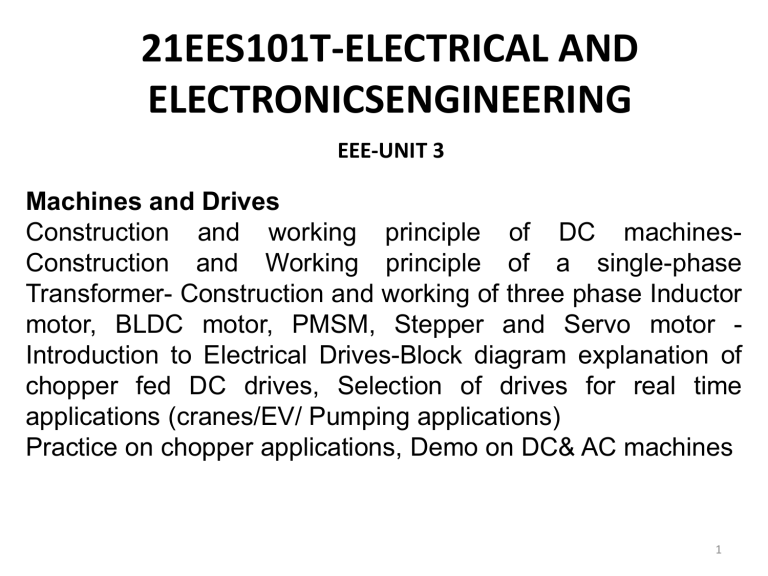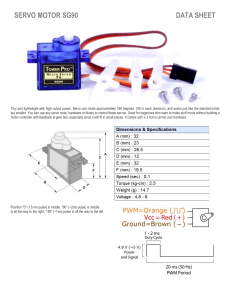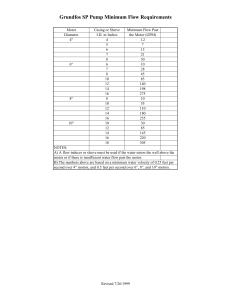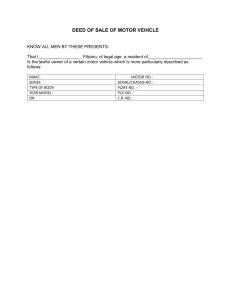
21EES101T-ELECTRICAL AND ELECTRONICSENGINEERING EEE-UNIT 3 Machines and Drives Construction and working principle of DC machinesConstruction and Working principle of a single-phase Transformer- Construction and working of three phase Inductor motor, BLDC motor, PMSM, Stepper and Servo motor Introduction to Electrical Drives-Block diagram explanation of chopper fed DC drives, Selection of drives for real time applications (cranes/EV/ Pumping applications) Practice on chopper applications, Demo on DC& AC machines 1 2 3 4 Generators • Working Principle – Can be explained using velocity components Generators-Working Principle • Case I: θ=0o • The velocity component (v) is in parallel with the flux lines or in other words, the angle between the velocity and flux lines is zero. • Hence the emf induced is zero. • E=0 Generators-Working Principle • Case II: 0o< θ < 90o • The velocity component is making an angle with the flux lines. • The velocity component is resolved into two components – vsinθ – Vcosθ • vcosθ is making 0o with respect to flux lines and is not doing any useful work. • The vsinθ is 90o with respect to flux lines and it is doing useful work and due to this, emf is induced. • emin<e<emax Generators-Working Principle • Case III: θ = 90o • The velocity component is making an angle 90o with the flux lines. • and due to this, emf is induced. • E=emax Generators-Working Principle • For remaining cases, the illustration is shown below, • The emf completes one complete cycle for 360o . Emf induced across the Brush • Emf induced alternating type • is the BECAUSE – during positive half cycle, the conductor comes under the influence of north pole – during negative half cycle, the conductor comes under the influence of south pole How to convert AC to DC? • It is observed that the emf induced is the alternating type, but it is required to obtain unidirectional emf from the DC machines. • The alternating emf can be converted into pulsating dc using the split ring/commutator. Commutators Copper Segments 13 14 Major applications for DC motors are: elevators, steel mills, rolling mills, locomotives, and excavators 15 Single Phase Transformer Principle of operation The transformer works on the principle of electromagnetic induction. In this case, the conductors are stationary and the magnetic flux is varying with respect to time. Thus, the induced emf comes under the classification of statically induced emf. The transformer is a static piece of apparatus used to transfer electrical energy from one circuit to another. The two circuits are magnetically coupled. One of the circuits is energized by connecting it to a supply at specific voltage magnitude, frequency and waveform. Then, we have a mutually induced voltage available across the second circuit at the same frequency and waveform but with a change in voltage magnitude if desired. These aspects are indicated in Fig. 16 Construction The following are the essential requirements of a transformer: (a) A good magnetic core (b) Two windings (c) A time varying magnetic flux The transformer core is generally laminated and is made out of a good magnetic material such as transformer steel or silicon steel. Such a material has high relative permeability and low hysteresis loss. In order to reduce the eddy current loss, the core is made up of laminations of iron. ie, the core is made up of thin sheets of steel, each lamination being insulated from others 17 18 19 20 PMSM 21 22 23 24 Applications PMSM is widely used in robotics, machine tools, actuators, and it is being considered in high-power applications such as industrial drives and vehicular propulsion. It is also used for residential/commercial applications. EV applications 25 BLDC Motor 26 27 How Does A Brushless DC Motor Work? BLDC Motor operation is based on the attraction or repulsion between magnetic poles. Using the three-phase motor as shown in figure below, the process starts when current flows through one of the three stator windings and generates a magnetic pole that attracts the closest permanent magnet of opposite pole. The rotor will move if the current shifts to an adjacent winding. Sequentially charging each winding will cause the rotor to follow in a rotating field. The torque in this example depends on the current amplitude and the number of turns on the stator windings, the strength and the size of the permanent magnets, the air gap between the rotor and the windings, and the length of the rotating arm. 28 29 30 31 Applications Brushless DC motors (BLDC) use for a wide variety of application requirements such as varying loads, constant loads and positioning applications in the fields of industrial control, automotive, aviation, automation systems, health care equipments etc. EV applications Fans, pumps and blowers. 32 33 Stepper motor • Rotated through fixed angular steps • PWM Signal as a input • Directly controlled via computers,Microprocessor and PLC • No feedback • Suitable where Precise speed and position control is required • Develops Torque from 1 micro Nm(wrist watch motor) to 40 Nm • Power 1watt to 2500watt • Rotor has no windings ,no brushes and commutators 7/27/2023 brsr/2018-19/odd/emaa/synchronous and special machines 34 Stepper motor construction is quite similar to DC motor. It also has a permanent magnet as Rotor. Rotor will be in the center and will rotate when force is acts on it. This rotor is surrounded by a number of stator which is wound by magnetic coil all over it. Stator will be placed as close as possible to rotor so that magnetic fields in stators can influence rotor’s movement. To control the stepper motor each stator will be powered one by one alternatively. In this case the stator will magnetize and act as an electromagnetic pole exerting repulsive force on the rotor and pushes it to move one step. Alternative magnetizing and demagnetizing of stators will move the rotor step by step and enable it to rotate with great control. 35 Types of Stepping Motors Permanent Magnet Stepper Motor • Permanent magnet motors use a permanent magnet (PM) in the rotor and operate on the attraction or repulsion between the rotor PM and the stator electromagnets. • This is the most common type of stepper motor as compared with different types of stepper motors available in the market. Variable Reluctance • • Variable reluctance (VR) motors have a plain iron rotor and operate based on the principle that minimum reluctance occurs with minimum gap, hence the rotor points are attracted toward the stator magnet poles. The stepper motor like variable reluctance is the basic type of motor and it is used for the past many years. As the name suggests, the rotor’s angular position mainly depends on the magnetic circuit’s reluctance that can be formed among the teeth of the stator as well as a rotor. Hybrid • This is a combination of above two motor permanent and variable reluctance stepper motor. This motor consists of permanent magnetic toothed rotor like the ones in permanent magnet stepper motor with set of north and south poles in it. Also just like variable reluctant motor the stators have teeth in it. 27-07-2023 36 Few teeth of stator will be aligned to teeth of rotor while others will not be aligned to each other. When stator is magnetized by supplying current to it, magnetic flux drives the rotor to move by one step. The presence of teeth in both stator and rotor changes the magnetic flux and drives the motor by steps as intended. The Hybrid synchronous motor is most popular since it has high torque and resolution. Driving modes like half step can even increase the resolution of this motor. While full step or microstepping can be used to increase the torque, accuracy and smooth working. The hybrid motor is most popular because of the advantages it hold but comes with high cost due to its complex construction. 27-07-2023 37 Variable Reluctance Stepper Motor • It consists of a wound stator and a soft iron multi-tooth rotor. • The stator has a stack of silicon steel laminations on which stator windings are wound. • Usually, it is wound for three phases which are distributed between the pole pairs. • The rotor carries no windings and is of salient pole type made entirely of slotted steel laminations. • The rotor pole’s projected teeth have the same width as that of stator teeth. • The number of poles on stator differs to that of rotor poles, which provides the ability to self start and bidirectional rotation of the motor. 27-07-2023 38 Cross section model of 3-ph VR stepper motor and winding arrangement 27-07-2023 39 VR Stepper motor has following modes of operation 1. 1 phase ON (or) Full step operation mode 2. 2 phase ON mode 3. Alternate 1 phase ON and 2 phase ON mode (or) Half step operation mode 4. Micro stepping operation mode 27-07-2023 40 Working of Variable Reluctance Stepper Motor • The stepper motor works on the principle that the rotor aligns in a particular position with the teeth of the excitation pole in a magnetic circuit wherein minimum reluctance path exist. • Whenever power is applied to the motor and by exciting a particular winding, it produces its magnetic field and develops its own magnetic poles. • Due to the residual magnetism in the rotor magnet poles, it will cause the rotor to move in such a position so as to achieve minimum reluctance position and hence one set of poles of rotor aligns with the energized set of poles of the stator. • At this position, the axis of the stator magnetic field matches with the axis passing through any two magnetic poles of the rotor. 27-07-2023 41 • When the rotor aligns with stator poles, it has enough magnetic force to hold the shaft from moving to the next position, either in clockwise or counter clockwise direction. • The stepper motor works on the principle that the rotor aligns in a particular position with the teeth of the excitation pole in a magnetic circuit wherein minimum reluctance path exist. 27-07-2023 42 43 44 45 46 47 48 49 27-07-2023 50 Applications • • • • • • • • • computer peripheral textile industry ROBOTICS Type writers Line printers Tape drives Floppy disk drives NC machines Process control system 7/27/2023 brsr/2018-19/odd/emaa/synchronous and special machines 51 Servo Motor Servo is an electromagnetic device uses a negative feedback mechanism to converts an electric signal into controlled motion. Basically, servos behave like as actuators which provide precise control over velocity, acceleration, and linear or angular position. It consists of four things: DC motor, position sensor, gear train, and a control circuit. The gear mechanism connected with the motor provides the feedback to the position sensor. If the motor of the servo is operated by DC then it is called a DC servo motor and if it is operated by AC then it is called as AC servo motor. The gear of the servo motor is generally made up of plastic but in high power servos, it is made up of metal. 52 Types of Servo Motors on the Basis of Rotation Positional Rotation Servos: Positional servos can rotate the shaft in about half of the circle. Also, it has the feature to protect the rotational sensor from over-rotating. Positional servos are mainly used in limbs, robotic arms, and in many other places. Continuous Rotation Servos: Continuous servos are similar in construction to the positional servo. But, it can move in both clockwise and anticlockwise directions. These types of servos are used in radar systems and robots. Linear Servos: Again linear servos are also like a positional servo, but with additional gears to the adjust the output from circular to back-and-forth. These type of servos are used in high model airplanes and are rare to find on the stores. 53 On the Basis of Operating Signal (i) Analog Servomotors: Analog servos are operated over PWM (Pulse Width Modulation) signals. (ii) Digital Servomotors: Digital Servo receives signal and acts at high-frequency voltage pulses. Digital servo gives a smooth response and consistent torque, due to faster pulse. Digital servos consume more power than an analog servo. On the Basis of Operating Power (i) DC Servo Motor (ii) AC Servo Motor 54 Servo motor AC Servo motor DC Servo motor Brushless Servo motor Servomotor differ from large industrial motor in following respects:1. They produce high torque at all speeds including zero speed. 2. They are capable of holding a static (i.e. no motion) position. 3. They do not overheat at standstill or lower speed. 4. Due to low-inertia, they are able to reverse direction quickly. 5. They are able to accelerate and de-accelerate quickly. 7/27/2023 brsr/2018-19/odd/emaa/synchronous and special machines 55 Servo Motor-DC • They produce high torque at all speeds including zero speed. • They are capable of holding a static(i.e. no motion) position. • They do not overheat at standstill or lower speeds. • Due to low-inertia, they are able to reverse directions quickly. • They are able to accelerate and decelerate quickly. • They are able to return to a given position time after time without any drift. Construction of Servo Motor: 57 Servo Motor-DC Seperately Excited or permanent magnet dc motor. Speed is varied by varying armature voltage. Armature is made of large resistance hence T/N characteristics is linear. Stator Winding: This type of winding wound on the stationary part of the motor. It is also known as field winding of the motor. Rotor Winding: This type of winding wound on the rotating part of the motor. It is also known as an armature winding of the motor. Bearing: These are of two types, i.e, font bearing and back bearing which are used for the movement of the shaft. Shaft: The armature winding is coupled on the iron rod is known as the shaft of the motor. Encoder: It has the approximate sensor which determines the rotational speed of motor and revolution per minute of the motor. 59 Closed loop system - Servo Motor: 60 Working of Servo Motors The servo has a position sensor, a DC motor, a gear system, a control circuit. The DC motor run at high speed and low torque when getting power from a battery. The position of shaft senses by position sensor from its definite position and supply information to the control circuit. The reduction gearbox is connected to a shaft which decreases the RPM of the motor. The output shaft of the reduction gearbox is the same as of motor which is connected with encoder or potentiometer. The output of the encoder is then connected to the control circuit. The wires of the servomotor are also connected to the control circuit. The motor control through microcontroller by sending signals in the form of PWM which decodes the control circuit to rotate the motor in required angle the control circuit moves the motor in a clockwise or anticlockwise direction, with this the shaft also rotates in the desired direction. 61 Servo Motor-AC Two-phase squirrel cage induction type and are used for low power applications. However recently 3-phase induction motors have been modified for high power servo systems which had so far been using high power dc servomotors. Servo Motor-AC Control phase is supplied with a variable voltage of the same frequency as the reference phase but is phase-displaced by 900 (electrical). The N/T are controlled by the phase difference between the main and control windings. Reversing the phase difference from leading to lagging reverses motor direction Applications of Servo Motors They are used to control the positioning and movement of elevators in radio controlled airplanes. They play an important role in robotics information of robot because of their smooth switching on or off and accurate positioning. They are used in hydraulic systems to maintain hydraulic fluid in the aerospace industry. In radio controlled toys these are also used. They are used to extend or replay the disc trays in electronic devices such as DVDs or Blue-ray Disc players. They are used to maintain the speed of vehicles in the automobile industries. 64 Applications • • • • Radar tracking and guidance systems Process controls Computers Machine tools Electrical Drives Diesel/petrol/gas/stream engines, hydraulic motors, electric motors 66 Advantages of Electrical Drives 67 Block Diagram of Electric Drive System 68 Components in electric drives Motors • DC motors - permanent magnet – wound field • AC motors – induction, synchronous • brushless DC • Applications, cost, environment • Natural speed-torque characteristic is not compatible with load requirements Power sources • DC – batteries, fuel cell, photovoltaic - unregulated • AC – Single- three- phase utility, wind generator - unregulated Power processor • To provide a regulated power supply • Combination of power electronic converters • More efficient • Flexible • Compact • AC-DC, DC-DC, DC-AC, AC-AC 69 Components in electric drives Control unit • Complexity depends on performance requirement • analog- noisy, inflexible, ideally has infinite bandwidth. • DSP/microprocessor – flexible, lower bandwidth - DSPs perform faster operation than microprocessors (multiplication in single cycle), can perform complex estimations • Electrical isolation between control circuit and power circuit is needed: • Malfunction in power circuit may damage control circuit • Safety for the operator • Avoid conduction of harmonic to control circuit 70 Components in electric drives Sensors • Sensors (voltage, current, speed or torque) is normally required for closed-loop operation or protection. • Electrical isolation between sensors and control circuit is needed. • The term ‘sensorless drives’ is normally referred to the drive system where the speed is estimated rather than measured. 71 Applications of Electric Drives Transportation Systems Rolling Mills Paper Mills Textile Mills Machine Tools Fans and Pumps Robots Washing Machines etc 72 Chopper fed dc drive 73 Factors for selection of Electrical Drives 74 Solar Powered Pump System 75 Solar Powered Pump Drives with reciprocating pump For pump ratings of 1 kW and above, three phase induction motor drive is employed. A PWM voltage source inverter with maximum-power-point- tracker is used for variable frequency control of the squirrelcage induction motor. Solar pump drive using induction motor 76 Solar Powered Pump Drives with battery Solar Powered Pump Drives with an intermediate battery, can also be used. The drive is fed from the battery charged by solar panel. Solar pump with a battery 77 Selection of drives and control schemes for lifts and cranes 78 Selection of drives and control schemes for lifts and cranes 1) Quick Lift: To allow a lightly loaded or empty hoist to move up and down faster than the base speed of the motor 2) Reverse Plug Simulation: When reversing directions, the inverter will decelerate at a faster rate than the normal deceleration rate. 3) Load Hold (Hang Time): To hold a load aloft at zero speed without setting the brake. Permit precise positioning of the load without delays normally associated with mechanical operation of the brake. 4) Fast Stop: To Rapidly decelerate the drive when the run command is removed i.e. when back-up limit switch is tripped 79 Selection of drives and control schemes for lifts and cranes 4) Speed Control: To accommodate five-speed cabin/pendant control, infinitely variable speed control, and a bi-polar voltage or analog current input speed command 5) Micro speed Positioning Control: To Permit extremely slow movements for greater positioning accuracy 6) Dual Upper and Lower Limit Switch Inputs: To accommodate limit-switch inputs on both the upper and lower travel of the hoist displayed. Further movement in hoist direction is prevented. 7) Torque Limits: Two sets of Fwd and rev torque limits are provided. 8) Torque Limited Acceleration / Deceleration Times: For smooth starts and stops to prevent load sway 80 EV Control schemes 81 EV Control schemes 82






